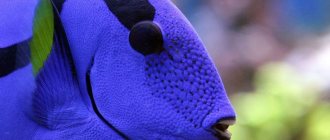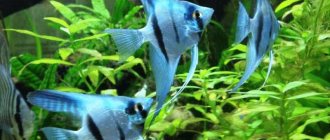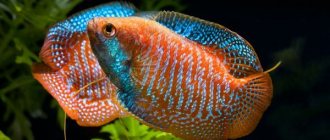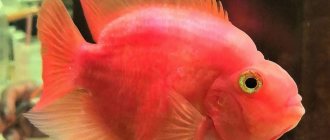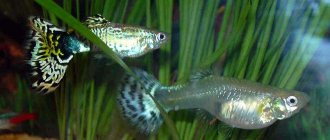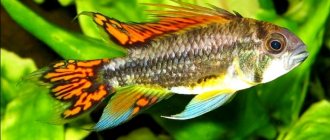The surgeonfish (Paracanthurus hepatus) is a family of exotic creatures that live in reef aquariums. Due to their bright colors and variety of species, tropical fish have gained great popularity. They were also featured in Finding Nemo and Finding Dory, making them stars of the aquarium hobby.
What does a surgeon fish look like?
Among the representatives of this family there are giants, reaching 1 m in length, and small aquarium specimens, no more than 16-18 cm. Most often in their natural habitat, species up to 40 cm in size are found. These are calm fish, herbivores, of a wide variety of colors: yellow , blue, orange, green, brown. The richness of colors is often complemented by motley spots and stripes randomly scattered throughout the body.
- all varieties have the following external characteristics: an ovoid, laterally compressed oval body, slightly elongated towards the tail and densely covered with scales;
- the eyes are large, high-set, they scan the territory well and see in the dark;
- a tiny elongated mouth adapted for eating algae;
- oblong dorsal and anal fins. The rays of the dorsal fin can seriously injure you.
Species features such as:
- horn-like growth on the forehead of triggerfish;
- high fins in zebrafishes;
- ctenochetes have particularly mobile teeth, etc.
- a pair (and sometimes two pairs!) of protective spines on either side of the tail
Yandex pictures
Why is it called that?
Thanks to these spines, in a “combat” state, sharp as scalpels, the fish is called a surgeon.
While nothing threatens her, the spines are hidden in special recesses in the body, covered with bright orange covers, which can be mistaken for an extra pair of fins. But in case of danger, the spikes extend and become perpendicular to the body. When attacking, the surgeon quickly rushes past the enemy, striking him with a poisoned tip.
Interesting fact: tourists vacationing on the sea coasts most often turn to doctors because of cuts on their legs caused by surgeons.
Yandex pictures
Why is it dangerous?
The surgeon fish got its unusual name because of its spines, which look like a razor or scalpel in appearance. They are very dangerous, both for people and for most other fish. The surgeon does not have the feeling of fear familiar to many fish, so he can calmly swim around a person walking or standing in the water, and then with a sharp movement inflict deep wounds. To this day, no one has been able to explain the behavior of the fish. There are many assumptions and versions, but they are all unconfirmed.
There are legends about the sharpness of the thorns. Some experts even note that they are so sharp that they could easily cut any shoe. For this reason, it is always important to be aware of possible dangers. In almost all cases, if you get a cut, you need to seek help at the hospital. There is a high probability that you will even have to get stitches.
An injection can be especially dangerous if poisonous mucus gets into the wound. It is found right on the scales of any fish. Usually, the ingress of mucus is accompanied by unpleasant, painful sensations and becomes a consequence of infection. If the cut is too dangerous, the worst outcome may be amputation of the limb. If a fish bites a person, he can lose so much blood that he will die immediately on the spot if it is far from the shore.
Danger to humans
The harmless appearance of a bright fish frolicking in shallow water often evokes a desire to get to know it better; Beginning divers sometimes forget why it got its name. Why is this meeting dangerous for a person?
The surgeonfish looks slow and even clumsy. But strong pectoral fins help her, if necessary, to instantly turn around and attack, and for no apparent reason. The spikes rip through safety shoes and cause deep cuts to the person. In addition, they are saturated with toxic mucus, which, when it gets into the wound, causes pain and inflammation.
In addition to intoxication and infection, a victim who does not receive timely medical attention is at risk of severe blood loss. If the attack occurred far from the shore, blood that gets into the water can attract sharks to the scene.
Therefore, long before entering the sea for the first time, it is useful to learn about the habits of the local fauna, so as not to get close to its potentially dangerous representatives.
Interesting fact: surgeonfish are actually very patient. She can withstand the pestering of annoying tourists for quite a long time, sailing to a safe distance for herself. But he does not tolerate attempts to stroke himself, as well as other familiarity.
Yandex pictures
Content requirements
To keep the fish, you need a reef marine aquarium with hard or soft corals. The surgeon fish adapts to new conditions much better than other species.
Diet and feeding frequency
Under natural conditions, adults eat zooplankton and algae. But in an aquarium, plant foods are a key component of the diet.
The fish get their own greens. To avoid the destruction of algae, you need to feed them blanched vegetables, oatmeal or special tablets with spirulina.
Several times a week, the fish are fed with fresh or frozen shrimp meat, sea fish fillets, and mussels.
Feeding is carried out 1-2 times a day. In this case, you need to spend a fasting day once a week.
Water characteristics
To provide the surgeon fish with comfortable living conditions, it is necessary to recreate its natural habitat.
If they get into alkaline salt water, there is a risk of ammonia poisoning.
Therefore, if there are any changes in the behavior of the fish, you should conduct a water analysis using special testers from pet stores.
The optimal parameters for aquarium fluid are as follows:
- Acidity - pH 8.1-8.4.
- Salinity - 35-36%.
- Carbonate hardness - dkH 8-11. If the indicator drops below 7, individuals begin to eat corals.
To obtain clear water, you will need to install a mechanical filter. Harmful impurities are removed using biofilters or treatment with bacteria that oxidize nitrites and ammonia.
In addition, chemical filters are placed in aquariums. Remains of waste products and food must be removed using a siphon, as they contribute to the accumulation of nitrogen-containing substances.
Filling the aquarium
When choosing what to fill your aquarium, you should take care of special algae that absorb calcium and phosphates, creating oxygen. Aquatic vegetation provides natural cover for blue tangs.
For these fish you can use the following plants:
Kaulerpu
Chaetomorpha
Halimeda
As a soil, it is customary to take coral chips with a fraction of up to 5 mm. Such a layer will maintain normal acidity, increasing the concentration of calcium and beneficial microelements.
To provide additional shelter for the fish, you can immerse various decorations in the aquarium: driftwood and grottoes. The elements are secured using pins or sealants.
Equipment and lighting
In order to prevent water evaporation and maintain salinity, it is necessary to install an automatic watering device in the aquarium. You can buy it at a pet store or build it yourself.
The next important element is the sump. This is a container with compartments for deep preparation of the environment. Mechanical water purification is carried out in this department. Organic particles are removed using a skimmer.
Activated carbon is used for chemical cleaning. The biocompartment is designed to process nitrites and ammonia. Disinfection of the aquarium space is carried out by exposure to ultraviolet rays from a lamp.
You can put a heating element in the sump with a temperature sensor and a thermometer that evaluates the current water temperature.
Optimal performance 1 W per 1 liter of volume. The required flow is created by a pump with a capacity of 8-10 liters per hour.
All devices are placed in a closed cabinet so as not to spoil the aesthetics of the container and to prevent excess noise during operation. To prevent water overheating, an air fan should be installed.
Proper lighting is required for corals and vegetation that perform photosynthesis. Fluorescent tubes or LED devices are used as lighting devices. The second option is preferable due to durability and increased glow intensity.
Compatibility with other types
The blue surgeon has a calm character, but other members of the family show aggression towards their neighbors.
They are not allowed to be kept in the same container as seahorses.
However, fish respond well to proximity to:
antias
perches
wrasses
Reproduction and lifespan
The surgeon fish does not have clearly defined sexual differences. Only by observing mating can one reliably distinguish individuals: the color of the male turns pale. They become sexually mature by one and a half to two years of age.
New moons, occurring from December to July, are the time when surgeonfish gather in large schools to spawn. After mating, groups of females separate from the school and swim to the surface of the water to spawn there. The eggs are tiny, up to 1 mm, and the female lays up to 40,000 of them at a time.
Interesting fact: in the equator zone, surgeonfish can spawn all year round.
The embryo in the egg develops for about a day, after which it becomes a disc-shaped, transparent larva, not yet resembling an adult. However, these little ones already know how to defend themselves. They do not have “scalpel” spines, but they have poisonous spiny fins that repel predatory larvae of insects, crustaceans and jellyfish. The larvae stay in the upper layers of water, where they feed on phytoplankton, and after 2 - 2.5 months they are ready to become fry.
They rush to the shore, where the waves carry them into small natural reservoirs. There, new changes occur within 4-5 days. The body of the future fry is covered with the first scales, the digestive system is formed, and most importantly, sharp outgrowths are formed near the host. Having grown stronger and gained in height and weight, the babies return to the ocean to find their way to the reefs.
There are many people who want to enjoy this little thing. But adult surgeonfish also have plenty of enemies, especially during spawning. Sharks, tuna, tiger perch... Predators are too large for a toxic scalpel to harm them, so the surgeon does not always defend himself from hunters, but prefers to hide among the corals.
In the natural environment, the surgeon fish lives 20-30 years, in captivity - 12-20 years.
Yandex pictures
Lifestyle and reproduction in captivity
Before buying black-tailed fish, you should prepare a spacious aquarium, since these animals have pronounced territoriality. Small individuals feel comfortable in one container, but as they grow older they become aggressive and enter into conflicts with their relatives.
Representatives of the royal species are distinguished by the most calm behavior, while zebrasomes need free space.
Puberty in fish begins at 2 years of age. Before spawning, they form large schools and begin to splash around at the very bottom. The female lays up to 37 thousand eggs at a time. The fry have an almost transparent body and do not have sharp spines.
Kinds
There are more than 70 species of the surgeonfish family in the World Ocean.
Here are the most famous:
- blue surgeon He is royal, he is also hepatus. Bright blue with dark spots, yellow tail with a black border. Active and mobile, but shy, hiding in crevices. Interesting feature: sleeps on his side.
- Arabian, or sohal. The largest and most aggressive, steel-colored with black stripes, fins with black edging. Interesting sickle-shaped tail, recognizable yellow spot closer to the gills. The spines are located at the base of the tail. The diet includes not only algae, but also crustaceans.
- white-breasted. Bright blue, black-headed, yellow dorsal fin, white anal fin. Vegetarian, not carnivorous at all.
- zebrasoma or sailfish. Due to the wide, sail-like fins, the shape resembles a triangle. The most popular species is blue with dark speckles, with a cute little snout and bright yellow pectoral fins and tail.
- fox fish. The body is yellow or light brown, with an elongated muzzle, reminiscent of a fox (which is why it is called that). When angry, it changes color and becomes covered in spots. Particularly dangerous: due to special glands, all its spiny fins are poisonous. The fry run in flocks, the adults prefer to be alone.
- Moorish idol. Transverse black and yellow stripes, with elongated tips of the fins, giving the body a triangular silhouette. The stigma is elongated, as if like a pipe.
- olive. Almost monochromatic, discreet color, with a small orange spot next to the eye. Spikes on the caudal fin.
- yellow-eyed ctenochete. There is a narrow yellow rim around each eye. Color ranges from light green to dark brown, with blue speckles.
- striped. A real zebra surgeon: on a light olive or silver background there are five dark transverse stripes. Females are practically no different from males. Gathers in flocks of up to 1000 individuals.
All species are similar in body shape, but differ in the variety of colors, habits, as well as the location and number of spines on the body.
Yandex pictures
Description of the species
The usual habitat for dangerous fish is the Red Sea, Great Barrier Reef, New Caledonia and Samoa in the Pacific Ocean. The fish lives at a depth of 35 meters.
Blue tang spend almost all of their time on the outer slopes of coral reefs. She hides between the corals, in the resulting rock crevices. Therefore, most often it can be seen in photos taken in the dark underwater. Adult fish like to live alone or in pairs. But judging by the photos in magazines, the fry move only in flocks. This makes them feel more comfortable.
Absolutely all varieties of the breed are similar in appearance to each other. Their length is from 12 to 45 cm. There is a dangerous blue surgeon fish, the length of which reaches one meter. The body shape of the sea dweller looks oval and compressed. Researchers often call it ovoid. It is slightly flattened right on the sides. The surgeon has two fins - anal and dorsal. Both are quite wide, so that the shape of the surgeon's body in most cases appears even more rounded. This attracts the attention of researchers.
The blue tang always has a pronounced caudal peduncle visible in photographs. It has dangerous spikes on its sides. If sea inhabitants feel calm, then they are simply “hidden” in their pocket. As soon as the surgeons sense minimal danger, their spikes immediately straighten out and become a real weapon in the fight against a person or any other creature.
The eyes of the blue surgeon are huge and set quite high. Thanks to this, the surgeon always has excellent orientation even in complete darkness. A person could not do that under any circumstances. The sea dweller's mouth is very small, located at the end of the slightly elongated muzzle. The teeth are medium in size, so surgeons often feed on algae. Their forehead is sloping. Activity is only during the day. From early childhood, fish protect their own territory. Experts say that this is simply called protection and is common to all inhabitants of the seas.
Lifestyle
The surgeonfish is active mainly during the daytime.
Interesting fact: some idae change color with the onset of darkness: they turn pale, darken, or become covered with new spots and stripes.
They easily get along with their own kind and with other reef inhabitants. This family has its own distinctive behavioral characteristics.
- In their habitat, surgeons are distributed evenly, without interfering with each other, as if respecting the personal boundaries of their relatives
- They equally zealously guard both their territory and group space (when they gather in schools for spawning)
- We can call surgeons social beings: in their environment there is a clearly expressed division into ranks, within which unconditional subordination is carried out. That is why they get along with each other and others easily.
- Young surgeons grow up independently, separately from adults
- Each population maintains its numbers by regulating the birth rate of new individuals
- By their very existence, lifestyle, and eating habits, surgeons maintain the biological balance of their environment. By eating the algal cover of reefs, they help the vital activity and distribution of corals.
The last circumstance is especially important. Corals are home to many marine life. The possible destruction of reefs is a step towards environmental disaster, so the role of surgeons in the ecosystem is very important.
Yandex pictures
What does it eat?
The surgeon is not a predator: his mouth is small, and his strong jaws and sharp small teeth are designed for plant food.
According to the diet, three groups can be distinguished:
- Those who feed on filamentous and microalgae. Together with food, these fish swallow sand, which helps the food mass to grind, getting into the gizzard. This is characteristic of the olive surgeon, dark, mate.
- They feed on common and calcareous algae, as well as invertebrates crawling on the surface of coral ledges. The sharp teeth of the surgeon easily gnaw and clean coral branches and the upper layers of peripheton - algae and microorganisms. This group does not have a muscular stomach. Example: Minke whale, Pearly white-spotted, Blue golden-backed tang.
- Those who eat the vegetative bodies of algae do not disdain the remains of invertebrates, and at the same time plankton. An example is the white-tailed tang.
In the event of a shortage of food resources, individuals gather in schools to collectively search for food.
Yandex pictures
Where does it live?
Coral reefs of the Pacific and Indian Oceans, Atlantic, Red, Caribbean and Arabian Seas are where surgeon fish can be found. It lives in shallow, sun-warmed waters and loves reefs rich in algae, full of crevices and secluded hiding places.
Interesting fact: in 2021, Black Sea fishermen accidentally caught a surgeonfish. How it appeared outside its habitat is unknown.
Because of its decorativeness and unpretentiousness, the surgeon is very popular with aquarists. Therefore, this ocean dweller can also be found in Russia: in aquariums and oceanariums.
Yandex pictures
